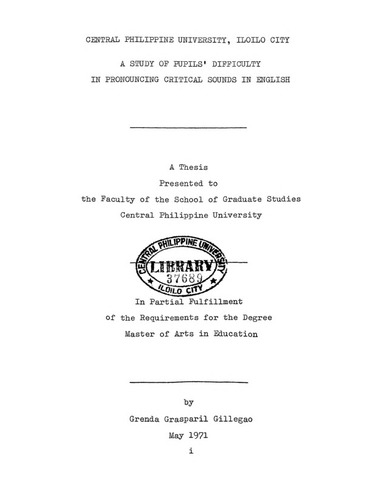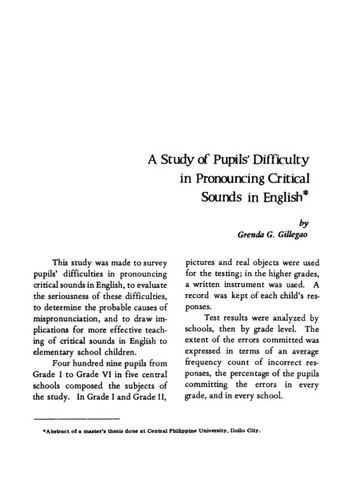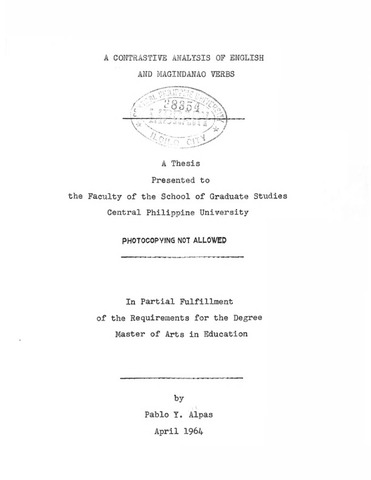Language used in text messaging and its relation to English language proficiency of grade ten students of selected private and public schools in Iloilo City

Page views
1,559Date
2017Thesis Adviser
Defense Panel Chair
Share
Metadata
Afficher la notice complète
Résumé
This study was conducted to determine and identify through survey, the influence of language used in (text) messaging and its relation to English language proficiency. It also identified the different variables that were associated or related to the English language proficiency such as: (1) gender; (2) type of school; (3) the different forms of electronic media; (4) frequency of (text) messaging that includes the number of (text) messages sent per day and the number of times engaged in (text) message chatting per day; (5) different social networking sites most frequently visited, accessed, and utilized by the students; (6) the number of hours spent in accessing and utilizing SNS; (7) type of message composer.
This study was exclusively and purposely conducted to Grade Ten students from selected private and public schools in Iloilo City. In getting the total number of respondents, purposive sampling, stratified random, and cluster sampling were used. A total of 286 respondents participated in the said study. To further present the effectiveness of the existence of the use of text in messages, a segregation between Standard form composers and Text form composers was made; making a division of 168 respondents who were Standard form composers and 118 respondents who were Text form composers.
This study used the Posttest Only Design or the After-Only Survey of the Non/Pre Experimental Designs. To determine the respondents’ English language proficiency, a 50-item researcher-made English Language Proficiency Test questionnaire in the form of survey was used. Furthermore, the manner of questionnaire distribution was through direct administration. In addition, the statistical tools that were used to analyze the data were frequency distribution, mean, standard deviation, ChiSquare, Cramer’s V, and P value with a 0.05 level of significance. The results revealed that a large number of the respondents who participated in the study were females. A number of respondents who participated in the study came from the public school. Most of the respondents sent (text) messages that ranged from zero to 20 in one day. A large number of them spent 10 to 20 hours a week accessing, browsing, and utilizing the Social Networking Sites over the Internet. “Facebook” was the most accessed Social Networking Site (SNS). Most of the respondents used a combination of either cellular phone, phablet, or the Internet as forms of electronic media in sending and posting of (text) messages. In terms of the language used in composing (text) messages, majority of the respondents utilized multilingual languages, particularly, English with or in combination with other languages such as Hiligaynon and Tagalog.
In terms of the overall English language proficiency level of the respondents, a number of them got a “Beginning” level of proficiency.
In the same vein, the language used in (text) messaging was significantly related to the forms of electronic media, English language proficiency and type of message composer. On the other hand, it was not significantly related to gender, type of school, frequency of (text) messaging, which include: the number of (text) messages sent per day and the number of times engaged in (text) message chatting.
There was a significant relationship between English language proficiency and the following: language used in (text) messaging, forms of electronic media, gender, type of school, and type of message composer. On the contrary, it was not significantly related to the frequency of (text) messaging, which include: the number of (text) messages sent per day and the number of times engaged in (text) message chatting.
Description
Abstract only
Suggested Citation
Casas, E. J. V. P. (2017). Language used in text messaging and its relation to English language proficiency of grade ten students of selected private and public schools in Iloilo City (Unpublished Master's thesis).
Type
ThesisSujet
Department
School of Graduate StudiesDegree
Master of Arts in EnglishShelf Location
GSL Theses 378.242 C264
Physical Description
xviii, 188 leaves
Collections
Les fichiers de licence suivants sont associés à ce document :
Excepté là où spécifié autrement, la license de ce document est décrite en tant que Attribution-NonCommercial-NoDerivs 3.0 Philippines
Related items
Showing items related by title, author, creator and subject.
-
A study of pupils' difficulty in pronouncing critical sounds in English
Gillegao, Grenda G. (1971)This study was made to survey pupils’ difficulties in pronouncing critical sounds in English, to evaluate the seriousness of these difficulties, to determine the probable causes of mispronunciation, and to draw implications ... -
A study of pupils’ difficulty in pronouncing critical sounds in English
Gillegao, Grenda G. (Central Philippine University, 1975)This study was made to survey pupils’ difficulties in pronouncing critical sounds in English, to evaluate the seriousness of these difficulties, to determine the probable causes of mispronunciation, and to draw implications ... -
A contrastive analysis of English and Magindanao verbs
Alpas, Pablo Y. (1954)After the Second World War, there appeared two camps of opinion concerning the teaching of English in the Philippines. The first camp is composed of those who cling to the use of English grammars based on Latin models and ...







